The Ice Lake Benchmark Preview: Inside Intel's 10nm
by Dr. Ian Cutress on August 1, 2019 9:00 AM EST- Posted in
- CPUs
- Intel
- GPUs
- 10nm
- Core
- Ice Lake
- Cannon Lake
- Sunny Cove
- 10th Gen Core
System Results (15W)
When testing a laptop system, there are various angles to consider on how to test: either user experience benchmarks, that are mostly single threaded and give a good boost to how systems implement a deal of turbo, or sustained benchmarks that test how the system performs when you push it. Intel has gone out of its way to emphasise the former for the next generation of mobile CPUs: they would prefer that reviewers stick to very user experience-like tests, rather than say, rendering programs. The problem there is that outside a number of canned benchmarks, it can be difficult. Users, and especially creators, that typically spend a lot on a premium device, might actually be doing sustained benchmarks.
Given the time that we had to test, we were actually limited in what we could arrange.

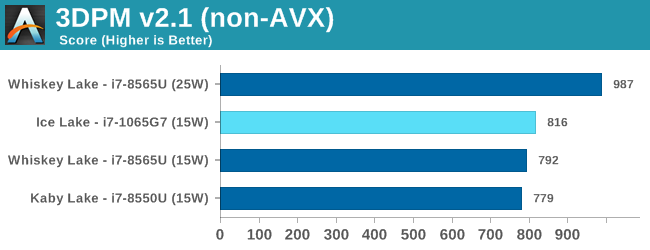

On AVX-512, the Ice Lake part destroys the competition.
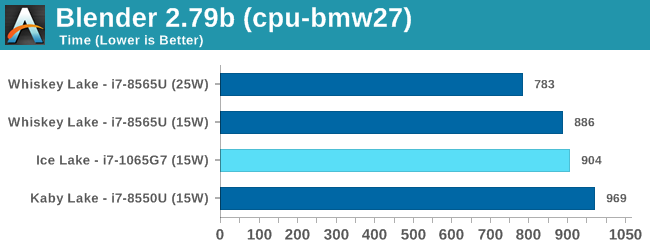
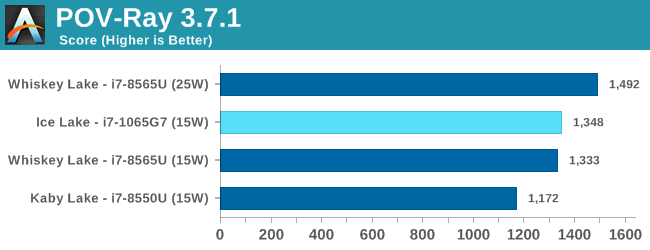


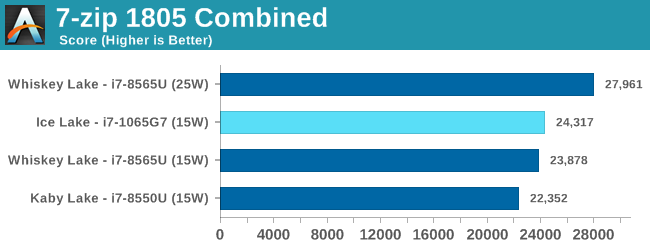
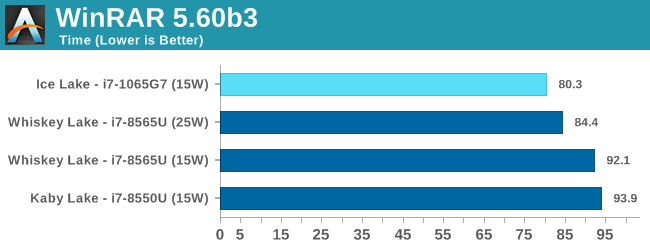
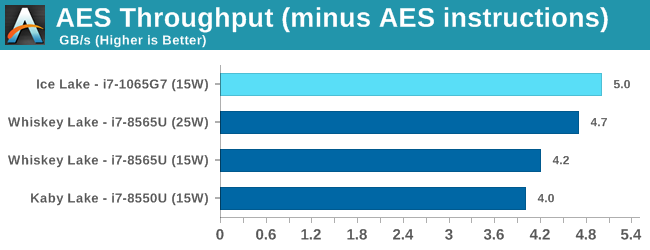
These last two tests are typically our more memory sensitive tests, and the LPDDR4X-3733 really does win out over the LPDDR3-2133 in the other systems.










261 Comments
View All Comments
0ldman79 - Friday, August 2, 2019 - link
Uh...They reworked the entire 10nm process to get it going.
This isn't impossible, it is expensive and time consuming.
They've spent the $$$ and at least a year working on it.
It is hardly unheard of that the single most successful tech company on the planet figured out a problem.
yeeeeman - Wednesday, June 17, 2020 - link
This is not a reasonable argument that he gave you. He just wanted, like a lot of people today, to show his hate for Intel. He's not seeing things straight anymore and I really don't understand this hate speech that many people have today about certain products. It is what it is, reviewers test them and there is not much else to say. I guess the reason is more people are being stupid these days.dguy6789 - Thursday, August 1, 2019 - link
Stop whining. The article is well written and provides plenty of information on Intel's new chip. Nobody gives a hoot about your tinfoil hat nonsense.close - Tuesday, August 6, 2019 - link
@dguy6789, obviously plenty of people do. AT did somehow manage to bungle repeatedly, always in positive ways for Intel, not so positive for the competition.And as these things go, if it turns out AT's current article is spot on then not much will change (past mistakes were still made). But if it turns out they were played *again* (assuming ignorance not bad intentions) and AT offers the same anemic retraction then it's going to be pretty clear where the editorial team stands.
AshlayW - Thursday, August 1, 2019 - link
You can't please everyone lol. I thought the article was great, informative and, imo, fair. Interesting to get a first look at the architecture and I enjoy reading your assessments on the results, puts it into context for me. :)I'm a pretty hardcore Ryzen fan too :P
MDD1963 - Friday, August 2, 2019 - link
Yes, how *dare* anyone publish *anything* that could be read as positive about new recent Intel products' performance gains, and the sheer audacity to do so within less than a month of the Ryzen 3000 launch! :/jospoortvliet - Friday, August 2, 2019 - link
It might be an obvious marketing ploy (I agree with that assessment) and that can be pointed out but a journalist wouldn’t be doing their job any better by ignoring this opportunity... both amd and intel as well as NVIDIA play these games all the time.brakdoo - Thursday, August 1, 2019 - link
Yeah Intel is trying to give journalists more info than the public for the past few months/quarters so that these people think they are special because they are "insiders" (they don't have much else to be proud of).These journalists talked so much about IPC over these months but it turned out to be just BS because IPC is nothing without frequency (to a certain extent AMD did the same stupid IPC thing). It is obvious that the frequency issue is not just about 10 nm but instead it's caused by this messed up architecture. Otherwise Intel would just sell 14 nm Ice lake CPUs...
They even fooled these tech sites with the graphics performance. It's barely faster than Iris plus 655.
AMD had a bad history of weird journalist events and giving too much NDA info but Intel turned it into a real shitshow.
Gondalf - Thursday, August 1, 2019 - link
Likely you have some problems with Sunny Cove that is clearly superior than Zen 2 even without fast desktop DRAM and without an insane amount of L3.Pretty certain you are trying to realize how fast will be Ice Lake EP in server space.
The end of a dream??? Yes it is.
Obviously Intel is preparing itself to finer nodes that will not allow fast clock speeds anymore but an intersting density instead.
This review is a nice example of what will be the future Intel core performance cadence in the next two years.
Many thanks Haifa Team.
About GPU, it is pretty good because now it performs at 15W level and without an expensive eDRAM. Try to run the new GPU within 28W and you will have an idea of the advantages of the new ark vs. 9.5.
0ldman79 - Friday, August 2, 2019 - link
Brakdoo is way off in his assertions, but I believe you have rose colored glasses too.Intel got the efficient process working, not the high performance one. They still have 14nm planned out for another year at least.
It isn't just the lithography that is the problem either, Sunny Cove is a different architecture, it just might not clock as high. We'll have to wait and see how that all works out.
I do agree though, speeds are probably going to stall if not regress moving forward. It's just a lot of amps going through a tiny circuit. 14nm might have been the sweet spot to get the highest clock speeds. Smaller circuits will only get hotter carrying the same current. Unless they significantly lower power usage it is going to be a problem.
Apparently .7v is the switching point for silicon semi-conductors, below that the transistors don't switch, so to go beyond 7nm or 5nm they're very likely going to have to move to a more conductive material to lower the switching point as well as resistance (heat buildup).
Interesting times...